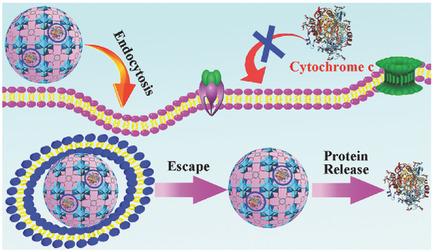当前位置:
X-MOL 学术
›
Adv. Funct. Mater.
›
论文详情
Our official English website, www.x-mol.net, welcomes your feedback! (Note: you will need to create a separate account there.)
Nanoscale Zr‐Based MOFs with Tailorable Size and Introduced Mesopore for Protein Delivery
Advanced Functional Materials ( IF 19.0 ) Pub Date : 2018-02-14 , DOI: 10.1002/adfm.201707356 Zhe Wang 1 , Shuanggang Hu 2 , Jian Yang 1 , Ajuan Liang 2 , Yongsheng Li 1 , Qixin Zhuang 1 , Jinlou Gu 1
Advanced Functional Materials ( IF 19.0 ) Pub Date : 2018-02-14 , DOI: 10.1002/adfm.201707356 Zhe Wang 1 , Shuanggang Hu 2 , Jian Yang 1 , Ajuan Liang 2 , Yongsheng Li 1 , Qixin Zhuang 1 , Jinlou Gu 1
Affiliation

|
Introduction of large pore in the primitive microporous metal–organic frameworks (MOFs) with tailorable particle size can endow them with desired properties for potential applications in the intracellular delivery of membrane‐impermeable proteins. However, no research is found to focus on this topic until now. Herein, a monocarboxylic acid (MA) and organic base comodulation strategy is developed to synthesize the hierarchically porous UiO‐66 nanoparticles. MA of dodecanoic acid is utilized to control the pore size while trimethylamine (TEA) plays a key role in modulating the nucleation of crystallization to regulate the particle size. In comparison with microporous UiO‐66, a model protein of cytochrome c (Cyt c) could be efficiently loaded into the mesoporous MOFs (mesoMOFs). The size‐dependent cellular uptake is also evaluated, and it is verified that mesoMOFs with particle size of 90 nm could be endocytosed into living cells with highest efficiency. These outstanding merits enable the current mesoMOFs not only to exhibit efficient encapsulation of Cyt c but also facilitate the protein delivery into the cytosol and subsequent endosomal escape. Given the exceptional chemical stability, hierarchically porous structure as well as tunable particle size, the elaborated mesoUiO‐66 nanoparticles might offer a promising platform for a variety of biomedical applications.
中文翻译:

基于纳米Zr的MOF,具有可定制的尺寸和引入的介孔,可用于蛋白质递送。
在原始的微孔金属有机框架(MOF)中引入具有可调节粒径的大孔,可以赋予它们所需的特性,以在膜不可渗透蛋白的细胞内递送中潜在应用。但是,到目前为止,还没有找到针对该主题的研究。。。。。。。。。。。。。。。。。。。。。。。。。。。。。。。。。。。。。。。。。。。。。。。。。。。。。。。。。。。。。。。。。。。。。。。。。。。。。。。。。。。。。。本文中,开发了一种单羧酸(MA)和有机碱共调节策略来合成分层多孔UiO-66纳米颗粒。十二烷酸的MA用于控制孔径,而三甲胺(TEA)在调节结晶成核以调节粒径方面起关键作用。与微孔UiO-66相比,细胞色素c(Cyt c)的模型蛋白可以有效地加载到中孔MOF(mesoMOF)中。还评估了大小依赖的细胞摄取,事实证明,粒径为90 nm的mesoMOF可以被内吞到活细胞中,效率最高。这些突出的优点使当前的mesoMOFs不仅能够有效地封装Cyt c,而且还可以促进蛋白质向细胞质中的传递以及随后的内体逃逸。鉴于出色的化学稳定性,分层多孔结构以及可调节的粒径,精心设计的mesoUiO-66纳米颗粒可能为各种生物医学应用提供有希望的平台。
更新日期:2018-02-14
中文翻译:

基于纳米Zr的MOF,具有可定制的尺寸和引入的介孔,可用于蛋白质递送。
在原始的微孔金属有机框架(MOF)中引入具有可调节粒径的大孔,可以赋予它们所需的特性,以在膜不可渗透蛋白的细胞内递送中潜在应用。但是,到目前为止,还没有找到针对该主题的研究。。。。。。。。。。。。。。。。。。。。。。。。。。。。。。。。。。。。。。。。。。。。。。。。。。。。。。。。。。。。。。。。。。。。。。。。。。。。。。。。。。。。。。本文中,开发了一种单羧酸(MA)和有机碱共调节策略来合成分层多孔UiO-66纳米颗粒。十二烷酸的MA用于控制孔径,而三甲胺(TEA)在调节结晶成核以调节粒径方面起关键作用。与微孔UiO-66相比,细胞色素c(Cyt c)的模型蛋白可以有效地加载到中孔MOF(mesoMOF)中。还评估了大小依赖的细胞摄取,事实证明,粒径为90 nm的mesoMOF可以被内吞到活细胞中,效率最高。这些突出的优点使当前的mesoMOFs不仅能够有效地封装Cyt c,而且还可以促进蛋白质向细胞质中的传递以及随后的内体逃逸。鉴于出色的化学稳定性,分层多孔结构以及可调节的粒径,精心设计的mesoUiO-66纳米颗粒可能为各种生物医学应用提供有希望的平台。



























 京公网安备 11010802027423号
京公网安备 11010802027423号